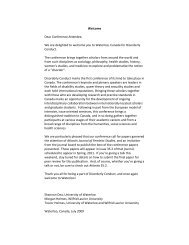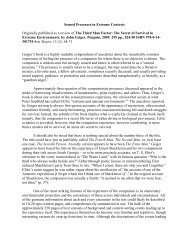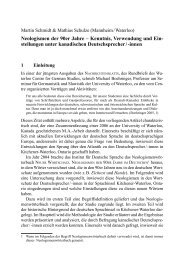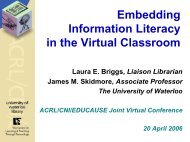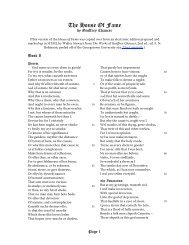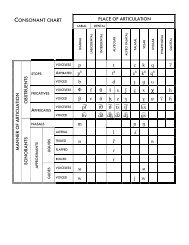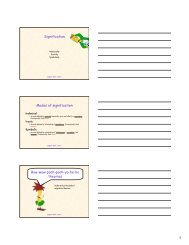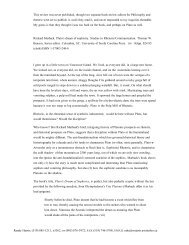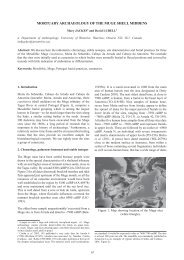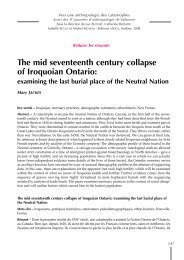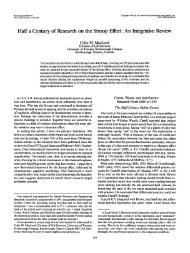Individual Differences in Learning and Memory: A Unitary ...
Individual Differences in Learning and Memory: A Unitary ...
Individual Differences in Learning and Memory: A Unitary ...
Create successful ePaper yourself
Turn your PDF publications into a flip-book with our unique Google optimized e-Paper software.
538 COLIN M. MACLEOD<br />
(Note 3) reports that her <strong>in</strong>flexible, language-bound subjects rely on order<br />
<strong>in</strong>formation that impedes the more semantic organization adopted by the<br />
flexible, language-optional subjects. Of course, the semantic strategy is<br />
more effective <strong>in</strong> solv<strong>in</strong>g the problem. Perhaps the availability of a control<br />
process to employ order <strong>in</strong>formation can be seen as one manifestation of<br />
the subject’s cognitive flexibility. Apparently, order sensitivity underlies<br />
a variety of <strong>in</strong>dividual differences, both <strong>in</strong> terms of personality <strong>and</strong> cogni-<br />
tion. This would be a worthwhile topic to follow up more systematically.<br />
While it would be a simple matter to outl<strong>in</strong>e isolated <strong>in</strong>dividual differ-<br />
ences <strong>in</strong> other control processes, I believe this might serve more to<br />
obscure than to clarify the issues. Research <strong>in</strong> this area is <strong>in</strong> need of a<br />
more unified approach if questions about optimal transfer strategies <strong>and</strong><br />
the <strong>in</strong>terrelationships of various (classes of) control processes are to be<br />
answered. What I have tried to illustrate is one possible framework,<br />
cognitive flexibility, <strong>and</strong> two areas to which it might be applied.<br />
Episodic Long-Term Store<br />
An obvious tactic for beg<strong>in</strong>n<strong>in</strong>g to disentangle the many attributes of<br />
LTS is the factor analysis of a wide array of long-term memory tasks. If<br />
certa<strong>in</strong> component processes are critical to several tasks, correspond<strong>in</strong>g<br />
factors should emerge. For example, factors correspond<strong>in</strong>g to temporal<br />
order or organizational cluster<strong>in</strong>g would be <strong>in</strong>tuitive c<strong>and</strong>idates. In an<br />
attempt to do this, Underwood, Boruch, <strong>and</strong> Malmi (Note 13) conducted a<br />
factor analysis on 22 variables from st<strong>and</strong>ard long-term memory tasks<br />
such as free recall, paired-associate learn<strong>in</strong>g, <strong>and</strong> verbal discrim<strong>in</strong>ation.<br />
Unfortunately, what appeared were five factors that seem to be highly<br />
task-bound (e.g., paired-associate learn<strong>in</strong>g <strong>and</strong> verbal discrim<strong>in</strong>ation).<br />
Although Carroll (1978) po<strong>in</strong>ts out that there seems to be a second-order<br />
factor correspond<strong>in</strong>g to associative memory, these results are still quite<br />
discourag<strong>in</strong>g. [Interest<strong>in</strong>gly, though, Underwood et al. suggest that sub-<br />
jects may possess sufficient flexibility to overshadow task-appropriate<br />
memory attributes.] Furthermore, Masson (Note 8) has factor-analyzed<br />
30 st<strong>and</strong>ard memory tasks <strong>and</strong> arrived at a similar impasse. For the<br />
present, at least, a different approach will be required.<br />
Consider a second approach proposed by Yen (1978) that is more <strong>in</strong> the<br />
spirit of the basic two-state model. Yen fitted a particular <strong>in</strong>formation<br />
process<strong>in</strong>g model (Rumelhart, Note 10) to the <strong>in</strong>dividual learn<strong>in</strong>g curves<br />
of grade-school students. She exam<strong>in</strong>ed two types of learn<strong>in</strong>g material,<br />
paired associates <strong>and</strong> word def<strong>in</strong>itions, f<strong>in</strong>d<strong>in</strong>g reliable <strong>in</strong>dividual ditfer-<br />
ences <strong>in</strong> two parameters of the model, acquisition rate, <strong>and</strong> long-term<br />
retention.4 The correlations between each of these parameters <strong>and</strong> her<br />
4 Hunt et al. (1973) report an analysis of the relationship between trials to acquisition <strong>and</strong><br />
long-term retention <strong>in</strong> paired-associate learn<strong>in</strong>g. Over three types of lists, they observed the



